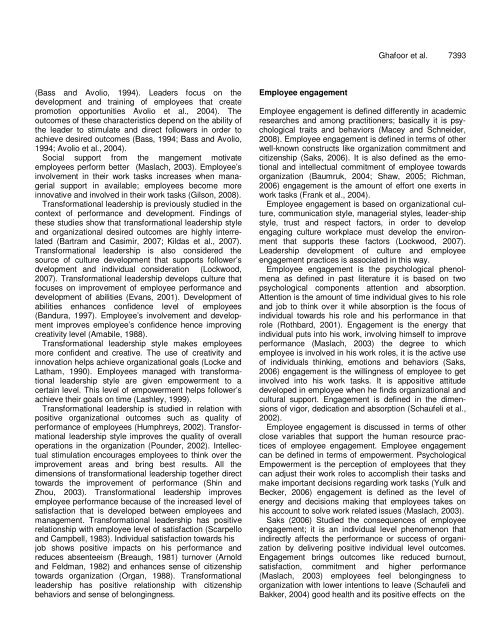Download Complete Issue (8760kb) - Academic Journals
Download Complete Issue (8760kb) - Academic Journals
Download Complete Issue (8760kb) - Academic Journals
You also want an ePaper? Increase the reach of your titles
YUMPU automatically turns print PDFs into web optimized ePapers that Google loves.
(Bass and Avolio, 1994). Leaders focus on the<br />
development and training of employees that create<br />
promotion opportunities Avolio et al., 2004). The<br />
outcomes of these characteristics depend on the ability of<br />
the leader to stimulate and direct followers in order to<br />
achieve desired outcomes (Bass, 1994; Bass and Avolio,<br />
1994; Avolio et al., 2004).<br />
Social support from the mangement motivate<br />
employees perform better (Maslach, 2003). Employee’s<br />
involvement in their work tasks increases when managerial<br />
support in available; employees become more<br />
innovative and involved in their work tasks (Gilson, 2008).<br />
Transformational leadership is previously studied in the<br />
context of performance and development. Findings of<br />
these studies show that transformational leadership style<br />
and organizational desired outcomes are highly interrelated<br />
(Bartram and Casimir, 2007; Kildas et al., 2007).<br />
Transformational leadership is also considered the<br />
source of culture development that supports follower’s<br />
dvelopment and individual consideration (Lockwood,<br />
2007). Transformational leadership develops culture that<br />
focuses on improvement of employee performance and<br />
development of abilities (Evans, 2001). Development of<br />
abilities enhances confidence level of employees<br />
(Bandura, 1997). Employee’s involvement and development<br />
improves employee’s confidence hence improving<br />
creativity level (Amabile, 1988).<br />
Transformational leadership style makes employees<br />
more confident and creative. The use of creativity and<br />
innovation helps achieve organizational goals (Locke and<br />
Latham, 1990). Employees managed with transformational<br />
leadership style are given empowerment to a<br />
certain level. This level of empowerment helps follower’s<br />
achieve their goals on time (Lashley, 1999).<br />
Transformational leadership is studied in relation with<br />
positive organizational outcomes such as quality of<br />
performance of employees (Humphreys, 2002). Transformational<br />
leadership style improves the quality of overall<br />
operations in the organization (Pounder, 2002). Intellectual<br />
stimulation encourages employees to think over the<br />
improvement areas and bring best results. All the<br />
dimensions of transformational leadership together direct<br />
towards the improvement of performance (Shin and<br />
Zhou, 2003). Transformational leadership improves<br />
employee performance because of the increased level of<br />
satisfaction that is developed between employees and<br />
management. Transformational leadership has positive<br />
relationship with employee level of satisfaction (Scarpello<br />
and Campbell, 1983). Individual satisfaction towards his<br />
job shows positive impacts on his performance and<br />
reduces absenteeism (Breaugh, 1981) turnover (Arnold<br />
and Feldman, 1982) and enhances sense of citizenship<br />
towards organization (Organ, 1988). Transformational<br />
leadership has positive relationship with citizenship<br />
behaviors and sense of belongingness.<br />
Employee engagement<br />
Ghafoor et al. 7393<br />
Employee engagement is defined differently in academic<br />
researches and among practitioners; basically it is psychological<br />
traits and behaviors (Macey and Schneider,<br />
2008). Employee engagement is defined in terms of other<br />
well-known constructs like organization commitment and<br />
citizenship (Saks, 2006). It is also defined as the emotional<br />
and intellectual commitment of employee towards<br />
organization (Baumruk, 2004; Shaw, 2005; Richman,<br />
2006) engagement is the amount of effort one exerts in<br />
work tasks (Frank et al., 2004).<br />
Employee engagement is based on organizational culture,<br />
communication style, managerial styles, leader-ship<br />
style, trust and respect factors, in order to develop<br />
engaging culture workplace must develop the environment<br />
that supports these factors (Lockwood, 2007).<br />
Leadership development of culture and employee<br />
engagement practices is associated in this way.<br />
Employee engagement is the psychological phenolmena<br />
as defined in past literature it is based on two<br />
psychological components attention and absorption.<br />
Attention is the amount of time individual gives to his role<br />
and job to think over it while absorption is the focus of<br />
individual towards his role and his performance in that<br />
role (Rothbard, 2001). Engagement is the energy that<br />
individual puts into his work, involving himself to improve<br />
performance (Maslach, 2003) the degree to which<br />
employee is involved in his work roles, it is the active use<br />
of individuals thinking, emotions and behaviors (Saks,<br />
2006) engagement is the willingness of employee to get<br />
involved into his work tasks. It is appositive attitude<br />
developed in employee when he finds organizational and<br />
cultural support. Engagement is defined in the dimensions<br />
of vigor, dedication and absorption (Schaufeli et al.,<br />
2002).<br />
Employee engagement is discussed in terms of other<br />
close variables that support the human resource practices<br />
of employee engagement. Employee engagement<br />
can be defined in terms of empowerment. Psychological<br />
Empowerment is the perception of employees that they<br />
can adjust their work roles to accomplish their tasks and<br />
make important decisions regarding work tasks (Yulk and<br />
Becker, 2006) engagement is defined as the level of<br />
energy and decisions making that employees takes on<br />
his account to solve work related issues (Maslach, 2003).<br />
Saks (2006) Studied the consequences of employee<br />
engagement; it is an individual level phenomenon that<br />
indirectly affects the performance or success of organization<br />
by delivering positive individual level outcomes.<br />
Engagement brings outcomes like reduced burnout,<br />
satisfaction, commitment and higher performance<br />
(Maslach, 2003) employees feel belongingness to<br />
organization with lower intentions to leave (Schaufeli and<br />
Bakker, 2004) good health and its positive effects on the

















